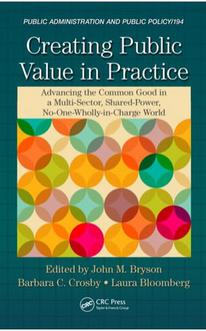Center for Integrative Leadership
Does public value magnitude matter?
Is it enough for a stakeholder to learn that your program produced public value, or do stakeholders want to know how much value was created? Put another way, is it adequate to demonstrate that a program has a positive return on investment for a community? Or does it have to have a higher return than all the alternative investments the community could have made?
I was asked this question today at a Center for Integrative Leadership Research Forum where I presented, “How Cross Sector Leadership Builds Extension’s Public Value.” It seems that the answer has to be yes, it does matter whether a program generates a large or small amount of public benefit relative to its cost.
A potential funder wants to direct dollars toward their highest use. Ideally, all programs would report a return using a common metric. The metric could be dollars for programs whose impacts can be monetized (i.e., converted to dollars); it could be some other common metric (e.g., amount of pollution remediation, high school graduation rate) for programs addressing similar issues. With common metrics, a funder could rank programs by return on investment and fund as many of the top programs as they can.
Such apples-to-apples comparisons must be rare, though, even for programs with common objectives. I also imagine that the magnitude of a programs’ expected public value–if it is known–will inform, but not drive a funder’s decision.
What has your experience been? Have you sought funding from a source that demands to know the expected return on their investment in terms of dollars or some other metric? Do you know of funders that use those metrics to rank programs by return?
Public value conference papers available
My paper, “Creating Public Value with Tax and Spending Policies,” for the Center for Integrative Leadership’s Creating Public Value Conference is now available online, along with the other foundation papers for the conference. And my contributed paper for the same conference, co-authored with Lisa Hinz and Scott Chazdon, is available with the other contributed papers here. Please keep in mind that the papers are all conference drafts and shouldn’t be cited or quoted without the authors’ permission. So, if you are interested in how a wide range of scholars view the creation of public value, register for the conference (September 20-22 in Minneapolis), read the papers, and come ready to discuss them with the authors and other conference participants from around the country. See you there!
Creating Public Value with Fiscal Policy
Have you studied the scholarship on defining, measuring, and creating public value outside of Cooperative Extension? Wonder how disciplines other than economics define and discuss public value? (Spoiler alert: They don’t all see eye to eye with economists!) Then you may be interested in an upcoming conference sponsored by the Center for Integrative Leadership at the University of Minnesota. The conference, titled Creating Public Value in a Multi-Sector, Shared Power World will be held in Minneapolis September 20-22, 2012.
I wrote one of the foundation papers for the conference on the topic of “Creating Public Value with Tax and Spending Policies.” While not specifically about Extension programs, the definition of public value I use in the paper is the same as that used in the “Building Extension’s Public Value” workshop. We were asked to summarize our papers in five key points, which is a great idea when conference-goers have a lot of papers to digest. Here are the key points from my paper:
1. According to the framework rooted in public sector economics, market failures (such as externalities, information gaps, and public goods) call for cooperative action to make society better off. Which sector should take the action–government, nonprofit, informal–depends on the type of organization that can most cost-effectively address the market failure. Whichever kind of organization acts, effectively addressing market failure can create public value.
2. Governments can create public value by focusing tax and spending policies on (1) achieving economic efficiency by addressing market failure and (2) addressing concerns about fairness embodied in the social welfare function.
3. An optimal tax and transfer policy raises the revenue necessary to fund desired government activities in a way that maximizes social welfare, thus achieving society’s redistributive goals, subject to technological and natural resource constraints.
4. The process through which policies are adopted does not resemble the planner’s problem in social choice theory. Political structures and government’s own failures combine to ensure that real fiscal policies are not the same as the recommendations that arise from the optimal tax literature.
5. Many tools are in place to help the federal and state governments focus tax and spending in ways that can maximize public value, and others are available if we can muster the will to support them.
My favorite lesson from the paper–maybe my favorite lesson from public sector economics in general–is that public value is not exclusively about efficiency, it is also about fairness. Making outcomes more efficient is only the first step. Optimal fiscal policy also addresses society’s concerns about the distribution of well-being among members, also known as fairness.
One more preview for the conference: UM Extension Leadership and Civic Engagement Educator Lisa Hinz and I are working on another paper for the conference on “Using Economic Principles to Show How Extension Education Programs Create Public Value.” I’ll share the abstract of that paper when it is ready, so stay tuned!

